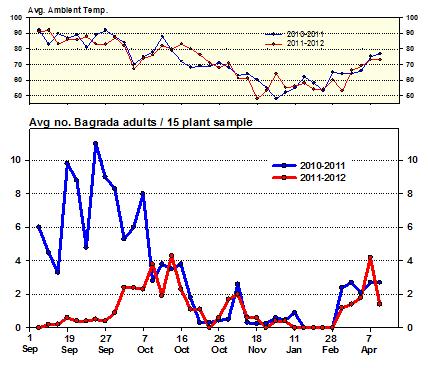 |
|
|
|

|
|||
| |
|||
In anticipation of the fall produce season, now is a good time to begin thinking about Bagrada bugs. Over the course of the summer, there have been a few reports of adults found in cotton, alfalfa, sudangrass or weeds, and Bagrada were found in sudangrass fields in the Yuma Valley as recently as last week. Perhaps more importantly, I have observed feeding signs on early cauliflower in both the Gila and Dome Valleys this week, and one PCA has reported seeing 1 or 2 adults on his early transplants. What this means in terms of infestation levels you might expect as planting starts to increase next week is anyone's guess. The graph below shows bagrada bug abundance on untreated broccoli and cabbage plantings at the Yuma Ag Center over the past two years. It clearly shows that last season Bagrada didn't begin to build on crops until almost October, whereas in 2010 large populations showed up at the onset of the planting season in early September. So again, what should PCAs expect for this season? Can't say for sure, but you should not become complacent just because you aren't finding any Bagrada on your first sets. It would be wise to assume they will eventually show up in some intensity in some of your acreage, and you should prepare for them accordingly. Preliminary research and anecdotal observations in fields conducted over the past 2 years suggests that direct-seeded and transplanted crops are most susceptible to Bagrada bug infestations during stand establishment (cotyledon to 4-leaf stage). Furthermore, results suggest that it doesn't take a large number of Bagrada adults to cause significant stand losses, and/or crop injury. Monitoring for Bagrada at stand establishment should focus on fresh feeding signs on new plant tissue, particularly before 9:00 am before adults become active. If you find fresh feeding signs and /or adults in young stands control should be intitiated. This can include chemigation with pyrethroids, and using contact insecticides (pyrethroids, Lannate, Lorsban) once stands are lined out and pipe is pulled. After stands are established and plant size increases up to the 2-3 leaf stage, or on tagged transplants, PCAs may consider alternating to dinotefuron (Venom/Scorpion) for protecting plants from Bagrada feeding. This neonicotinoid will also provide knockdown of adult whiteflies and nymphs. More information on Bagrada bug management on fall cole crops can be found in this Veg Update brief
Remember: When in Doubt-Scout. Click picture to listen to John To contact John Palumbo go to: jpalumbo@ag.arizona.edu
|
|||
| Back | |||
For questions or comments on any of the topics please contact Marco Pena at the Yuma Agricultural Center. |
|||
| Home | Cotton
| Veggies | Forages
| Grains | Citrus
| Crop x Crop Insects | Diseases| Weeds | Pesticides | Economics | News | Weather | Research | Photos | Contacts | General Info. Copyright © 2001 University of Arizona, College of Agriculture and Life Sciences Webmaster: Al Fournier (acis@ag.arizona.edu) |
|||

